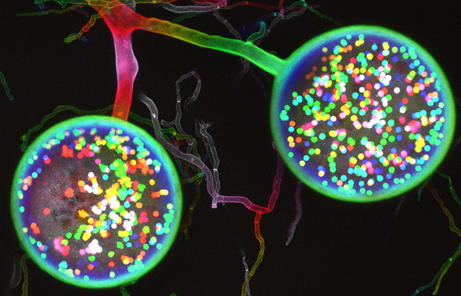Neither plant nor animal, fungi are among the most underappreciated organisms on Earth. They have played a crucial role in evolution—without them, neither terrestrial animals nor land plants would exist. A special type of fungi, called arbuscular mycorrhizal fungi (AMF), has supported life on land for at least 450 million years. These fungi form symbiotic relationships with plant roots, creating vast underground networks beneath homes, parks and sidewalks on every continent except Antarctica.
Although they appear to be simple, thread-like strands, AMF can absorb the carbon in the atmospheric CO2 fixed by their plant hosts and then store it in the ground. Professor Nicolas Corradi, who holds the University Research Chair in Microbial Genomics, is particularly interested in the unique features of their genetics.
“What drew me to the study of AMF was their rare genetic structure. These fungi have thousands of nuclei coexisting in the same cytoplasm, which is highly unusual. In 2016, we discovered that some of these nuclei belong to different genotypes, cohabiting within a single cell. This genetic oddity captivated me and shaped the direction of our research,” said Professor Corradi.

Professor Corradi and his students partnered with Micro-Tek, a leading agro-tech and forestry company, to translate scientific discoveries into practical applications for carbon sequestration. Their project focuses on developing new AMF strains, identifying their unique genetic traits through genome and RNA sequencing, and evaluating their carbon storage potential.
Using growth chambers, researchers compare plant growth with and without AMF inoculation. While visual differences may be subtle, plants grown with AMF consistently show greater dry weight, sequestered carbon, and phosphate intake. Detailed statistical analysis confirms that these increases are significant and not due to random variation. Genetic and genomic techniques further identify which traits drive these benefits.
“To truly understand biodiversity, we must explore both macroscopic and microscopic interactions. Overlooking ground-level dynamics hampers our understanding. It’s in exploring both the macro and micro that we uncover biodiversity’s essence.” - Professor Nicolas Corradi
Students play a key role in this research, from running greenhouse experiments to analyzing genetic data, and the partnership with Micro-Tek introduces these students to the commercial and industrial applications of scientific research.

Professor Corradi’s work has broad implications, particularly for Canada’s agricultural sector. His team is investigating the ability of native AMF strains to enhance crop yields, which would directly contribute to food security. On a global scale, their research supports carbon sequestration, as AMF currently capture approximately 18 gigatons of carbon annually. This could reduce atmospheric carbon while improving soil health and agricultural productivity. Their research could also lead to the development of biofertilizers enriched with AMF, which could provide a sustainable alternative to chemical fertilizers and promote eco-friendly farming worldwide.
This collaboration between academia and industry exemplifies innovation in tackling global challenges. By unlocking the potential of AMF, this research not only advances scientific knowledge, but also paves the way for a more sustainable and food-secure future. Although the ultimate goal of engineering these fungi poses significant challenges, it holds immense promise for breakthroughs in agriculture and environmental sustainability.
Read more:
- Corradi Lab
- Arbuscular mycorrhizal fungal genotype and nuclear organization as driving factors in host plant nutrient acquisition and stable carbon storage
- Arbuscular mycorrhizal fungi heterokaryons have two nuclear populations with distinct roles in host–plant interactions
- Mycorrhizal mycelium as a global carbon pool
